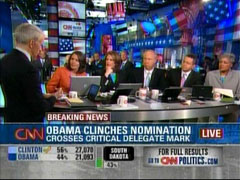In Structural Bias in Cross-National Perspective researchers examines how structural bias in news media reports can affect political conflicts. This article makes an argument for the importance of conflict framing. Content analysis of newspaper and television coverage shows that in American culture the dominance of government is weakened by journalists’ search for conflict. Political conflicts are then dramatized and fragmented to make an exciting story. Stories about government more often include oppositional voices, and focus on the negatives of political candidates. Media is also accused of giving more attention to one political party than the other. As a result, the media unintentionally cultivates Politian’s images. The ranges of arguments in political debates are also limited by agenda setting. All of these arguments can be directed towards the 2008 presidential election involving Barack Obama and John McCain, was well as their vice-presidential partners.
In Media framing biases and political power, Robert Entman claims that journalism is guilty of framing, and this framing is often biases. The media is thus able to sway voter’s opinions on political disputes. The study focuses on the Republican Vice Presidential nominee Sarah Palin. The study illustrates how slanted framing can shift in time and change the opinions of viewers. ABC and NBC were studied, and results emphasized the number of negative comments directed towards both Joseph Biden and Sarah Palin.


No comments:
Post a Comment